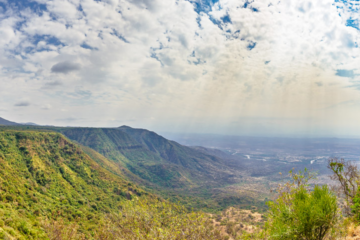The Rongai route ascents Kilimanjaro from the northeastern side of the mountain, along the border between Tanzania and Kenya. This route retains a sense of none spoilt wilderness and offers a different perspective on Kilimanjaro by approaching it from the north.
Day 1: Rongai Gate (1950m) – Simba camp (2600m)
Hiking time: 3h.
Distance: Approximately 6km.
Habitat: Forest (Montane vegetation).
Register at the Marangu park gate with a transfer (approximately 2 ½ hours) to the Rongai trailhead. Meet your guide and porters before you begin your hike from the Nale Moru village. The small winding path crosses maize fields before entering pine forest, and then climbs gently through a forest. The trail is not at all steep, but is rather a gentle hike through beautiful country. The first night’s camp is at Simba camp at about 2,600m.
Day 2: Simba Camp 2600m) – Kikelelwa Cave (3600m)
Hiking time: 6 – 7h
Habitat: Moorlands
The trail continues up towards Kibo, passing Second Cave (3450m) en-route, and reaching Kikelwa Cave at about 3,600m. The views start to open up and you begin to feel you’re on a really big mountain! (Kikelewa Caves).
Day 3: Kikelewa Cave (3600) – Mawenzi Tarn camp (4330m)
Hiking time: 3 – 4h
Habitat: Moorlands
A short but steep climb up grassy slopes offers superb views of this wilderness area. The vegetation zone ends shortly before you reach your next camp at Mawenzi Tarn spectacularly situated beneath the towering spires of Mawenzi. Spend the afternoon acclimatizing and exploring the area.
Day 4: Acclimatization day with a hike to the snow line of Mawenzi peak. Stay in the camp for dinner and overnight.
Day 5: Mawenzi Tarn camp (4330m) – Kibo hut (4700m)
Hiking time: 4 – 5hrs
Habitat: Alpine desert
Continue ascending on the east side of Kibo crossing the saddle between Mawenzi and Kibo taking 4 to 5 hours to reach Kibo Hut. The remainder of the day is spent resting in preparation for the final ascent, which begins around midnight. Overnight at Kibo Camp.
Day 6: (Summit Attempt) Kibo hut (4700m) – Uhuru Peak (5895m) – Horombo hut (3720m)
Hiking time: 8hrs to Uhuru, 6h to Horombo
Habitat: Stone scree / ice-cap summit
Distance: Approximately 6 km ascent, 18 km descent
You will rise around 23.30hrs, and after some tea and biscuits you shuffle off into the night. This is where the going really gets tough. The first section of the trail consists of a rocky path to the Hans Meyer Cave (5150m), also a good resting spot. The path then zigzags up to Gillman’s point (5 681m), which is located on the crater rim. This section is very steep with a lot of stone scree, requiring a great physical and mental effort. Probably, this is the most demanding section of the entire route. Do the Kili shuffle and move slowly. From Gillman’s Point you will normally encounter snow all the way up to Uhuru peak (5895m), the highest point in Africa. Total exhilaration and satisfaction – you made it. Weather conditions on the summit will determine how long you can spend, taking photographs, before the 3-hour descent back to Kibo hut. After a short rest you gather all your gear for the ascent and head down to Horombo hut (3 hours) where you will overnight. The return to Horombo hut will seem surprisingly fast compared to the ascent. The total time spent walking on this day is around 14 hours, so be prepared for a very tough day. Later in the evening you enjoy your last dinner on the mountain and well-earned sleep, filled with memories and stirring emotions.
Day 7: (Horombo hut (at 3720m) to Marangu Gate (at 1980m)
Hiking time: 6hrs
Distance: Approximately 18 km
After breakfast you continue your descent (6 hours), passing the Mandara hut, down to the Marangu gate.
At Marangu gate you sign your name and details in a register. This is also where successful climbers receive their summit certificates.
You now drive back to Moshi for a long overdue hot shower, dinner and celebration!





Tour Reviews
There are no reviews yet.
Leave a Review